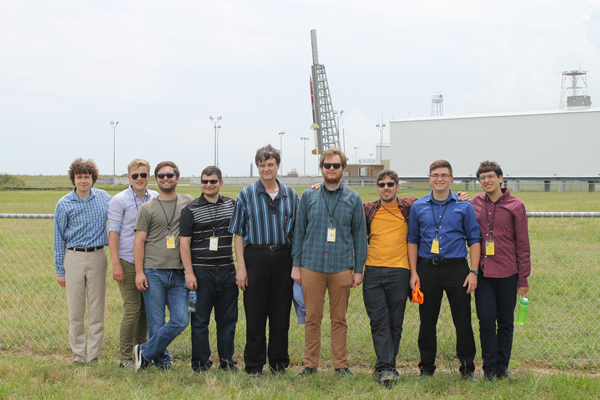
HOBOKEN, NJ, -- July 10th, 2019: On June 20, 2019 at 5:30 AM, three experiments developed at Stevens Institute of Technology in Hoboken, N.J. were launched 75 miles into space by NASA. The launch was the culmination of a yearlong project by eleven students and their faculty advisors. The project consisted of analyzing, designing, building, testing, redesigning, rebuilding, and retesting a sounding rocket payload.
The launch occurred at NASA’s Wallops Island Flight Facility on the Eastern Shore (Delmarva Peninsula) of the Virginia coast. The experiments were launched with stacked out-of-service military rockets: a 25-year-old Army rocket is placed atop a 15-year-old Navy rocket and the two are fired sequentially. This system allows for relatively low-cost access to space for experimentation. To see the official NASA launch video, click here:
https://www.youtube.com/watch?v=cZ_z25V9ZXU
The entire team consisted of Aiden Aquino, Chris Blackwood, Chris Cowan, Joshua Gross, Jack Hymowitz, Scott Maslin, Zack Shoop, Jesse Stevenson, Sam Yakovlev and Prof. Joseph S. Miles, recently returned from the annual Rock-SAT-C launch. Other team members, not pictured, consist of Reinier Lazaro and Prof. Nicholaus Parziale.
The payload designed and assembled by the group contains three experiments:
- The first project measures the high-speed pressure waves on the skin of the rocket. It does this using off the shelf low cost electronics to sample at a rate of 2 MHz. The pressure waves will be used to analyze the transition from laminar to turbulent boundary, air flow.
- The second experiment is a project to isolate mechanical vibrations due to rocket launches, from a small internal payload. The goal is to determine the best methodology for mounting sensitive electronics that would normally be damaged during a rocket launch. By comparing graphs of amplitude vs. frequency of the recorded results, the best method will be determined.
- The third experiment tested the creation of a reflow oven capable of soldering surface mount electronic components to a printed circuit board in the microgravity environment.
The RockSat-C program actively mentors students through a full engineering design process life cycle, leading them through the design phase in the Fall semester (Conceptual Design Review, Preliminary Design Review, and Critical Design Review), and coaching the teams through Testing and Integration Reviews as well as the Launch Readiness Review in the Spring. The RockSat-C manager also helps the teams with integration and launch at Wallops Flight Facility! The program is coordinated by The Colorado Space Grant Consortium while the Stevens team was sponsored by The New Jersey Space Grant Consortium under the auspices of Dean Siva Thangam at Stevens. The team also wishes to thank their advisors Professor Joseph S. Miles, and Professor Nicholas Parziale.
Anyone interested in participating in the program next year, which begins Monday August 26th, 2019, please contact Dean Siva Thangam at sthangam@stevens.edu, Professor Joseph S. Miles jmiles@stevens.edu, or phone the NJ Space Grant Office (B107-West) at 201-216-8964.
See more photos.
Read the report about the 2019 Rocket Launch Experiments.
